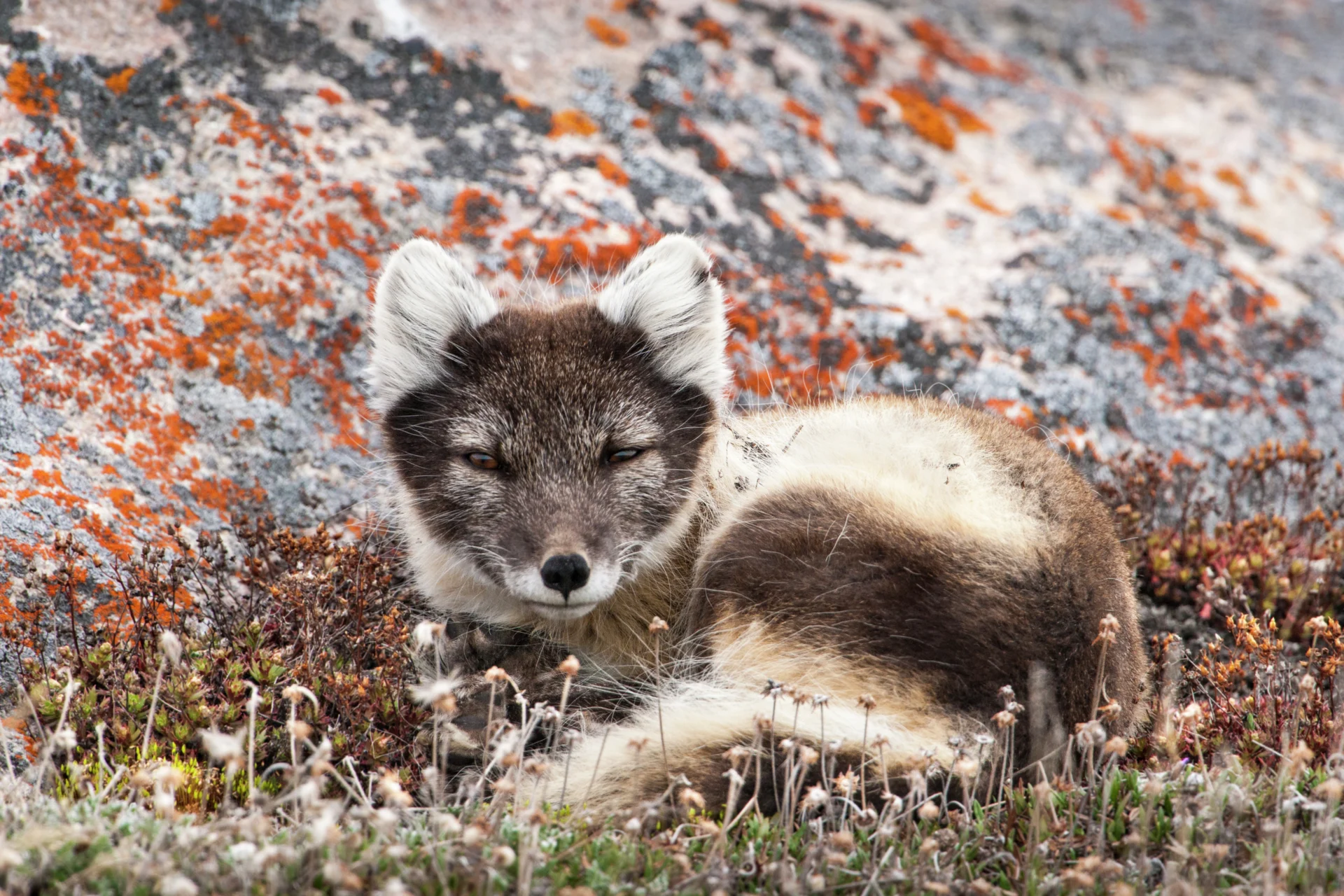Dyreliv i Nordvestpassagen
Nordvestpassagen er en uspoleret oase i det højarktiske område. Dyrene her – moskusokser, rensdyr, sæler og isbjørne – migrerer til mere behagelige klimaer eller tilpasser sig det iskolde landskab.
4 minutter at læse
Udvidede familiemedlemmer
Arktis er hjemsted for seks sælarter – grønlandssælen, klapmydsen, ringsælen, remmesælen, spættet sæl og harlekinsælen. De bemærkelsesværdige havpattedyr er isoleret med tykke lag af spæk og pels, der gør det muligt for dem at søge efter føde på dybder på mere end 2000 meter i iskoldt vand og holde vejret i op til to timer.
Med en vægt på op til to ton er hvalrossen den største af underordenen pinnipedia, som sæler også hører til. De læderagtige kødædere mangler den pels, som sæler har, og er i stedet afhængige af spæk og deres evne til at bremse deres hjerteslag for at overleve i det iskolde vand. Hvalrosserne er utroligt sociale dyr, der ligger sammen på isen og gør ad hinanden.
Tænder som redskab
Hvalrossens videnskabelige navn er odobenus rosmarus, det latinske ord for "tandgående søhest". Et passende ord, fordi deres ikoniske stødtænder faktisk er hjørnetænder og har været kendt for at vokse op til næsten en meter. Hannerne har større stødtænder end hunnerne, og stødtænderne bliver ved med at vokse hele deres liv. De kan bruges som redskaber til at hjælpe en hvalros med at trække sig op på isflager eller som våben til at hjælpe hannen med at forsvare sit territorium.
Polarrovdyr
Isbjørnene hører naturligt til på Nordkalotten og er rovdyr, der spiser ringsæler og remmesæler. Med deres fantastiske, hvide pels og en højde i oprejst stilling på tre meter er isbjørne, der vandrer alene rundt, noget af et syn. Spejd omhyggeligt efter isbjørne i det sneklædte landskab. Isbjørne fødes i huler, der er udgravet i dybe snedriver på landjorden, men de tilbringer det meste af deres liv på havisen – afhængigt af havets føde. Derfor er de også den eneste bjørneart, der betragtes som havpattedyr. Man kan muligvis få et glimt af en af de sjældne skabninger langs kysten.
En varm usynlighedskappe
Under deres karakteristiske, hvide pels er isbjørnenes hud helt sort. Det hjælper den med at absorbere sollys gennem pelsen. Isbjørnens pels har ikke noget hvidt pigment, men består af hule hår, der spreder synligt lys og holder dem camoufleret mod havisen. Et tæt lag af underpels og et yderligere lag spæk isolerer kroppen, så isbjørnen kan holde sig varm.
Sommernaboer
Man tror måske ikke, at et sted, der så ofte er dækket af sne, er noget for en planteæder. Men store flokke af moskusokser og rensdyr græsser faktisk side om side i sommermånederne og lever af tundraens græs og planter. Når temperaturen falder, og der kommer mere sne om vinteren, skilles deres veje. Rensdyrene migrerer sydpå til et mere beskyttet klima, mens moskusokserne bliver.
Hvis man ser en flok rensdyr, bemærker man måske, at selv deres snuder og hove er dækket af pels. Pelsen under deres hove giver dem et godt greb, når de går på is, mens pelsen, der dækker deres snuder, varmer den kolde luft, før den når deres lunger. Man bemærker måske en moskusokses sjuskede pels, men det er den kraftige lugt, som hannerne udsender i løbet af parringssæsonen, der har givet inspiration til oksens navn.
Gevirer som vokser ud igen
Det, der adskiller rensdyr fra andre i hjortefamilien, er, at både hanner og hunner har gevir. I det tidlige udviklingsstadium er de dækket af et lag af blødt dun eller hud, der giver næringsstoffer til geviret og fremmer væksten. Når de er færdige med at vokse, taber rensdyret huden og afslører skarpe, rødplettede gevirer. Kort tid herefter falder selve gevirerne af og vokser ud igen i løbet af et år
Mestre i forklædning
Den cirka en halv meter store polarhare er begavet med en utrolig tilpasningsevne – en pels, der skifter farve. Om vinteren kan en sovende hare let forveksles med en stor snebold, og om sommeren er dens pels blågrå og matcher områdets klipper og vegetation. Sammen med harens evne til at nå hastigheder på 60 km i timen er pelsfarven uvurderlig, når den forsøger at komme væk fra det farlige rovdyr, polarræven.
Sommeren er så kort i de områder af Nordvestpassagen, hvor vi sejler, at polarharer, der lever der, ikke får mange chancer for at ændre deres pelsfarve, så de er hvide året rundt.
